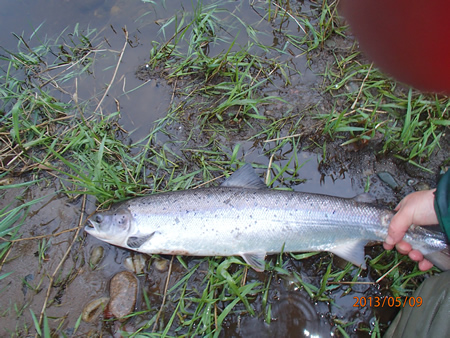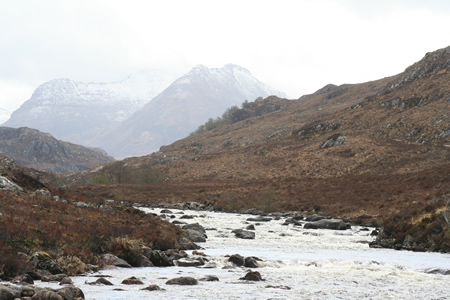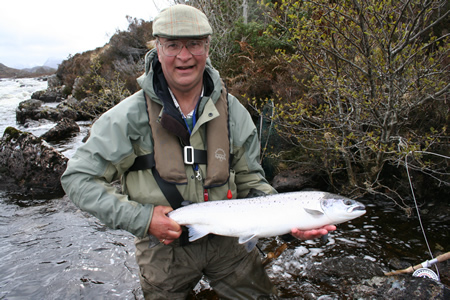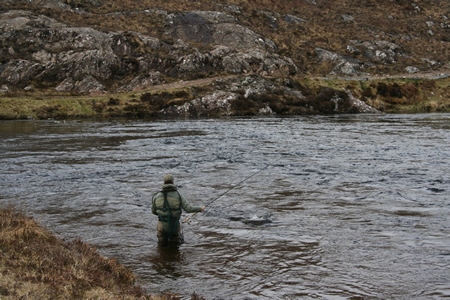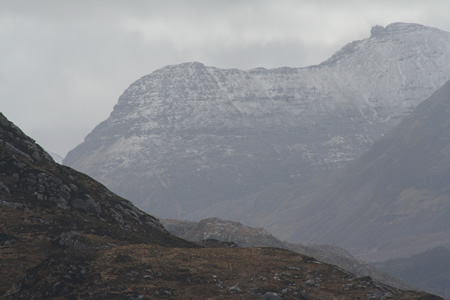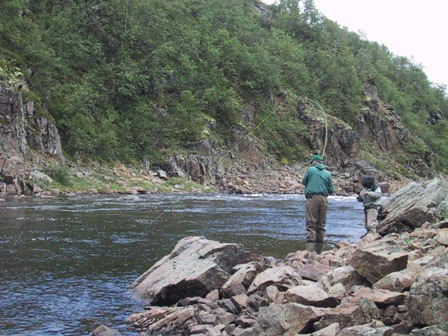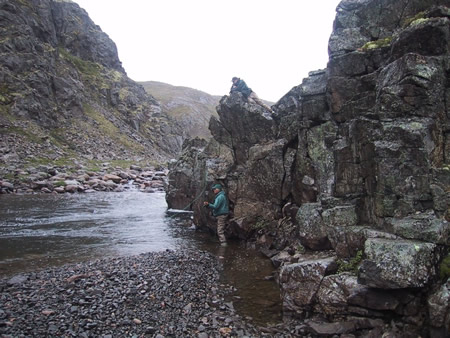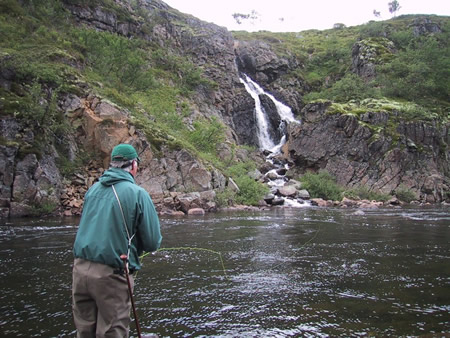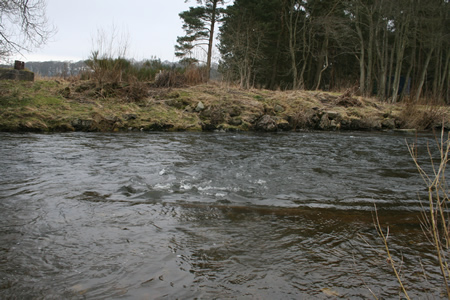Here is the decision.
Marine Works (Environmental Impact Assessment) Regulations 2007 (Regulation 22)
Environmental Impact Assessment Consent Decisio
Project Title: GSK Montrose Tidal Array
Applicant: GlaxoSmithKline (GSK)

Montrose Turbines site
Location: River South Esk Estuary, Montrose
1. Introduction
This document constitutes an environmental impact assessment (EIA) consent decision
under regulation 22 of the Marine Works (Environmental Impact assessment) Regulations
2007 (MWR) (as amended) (MWR), in respect of an application which has been submitted
by GSK to:
Marine Scotland, the licensing authority on behalf of the Scottish Ministers, for a Marine
Licence under the Marine (Scotland) Act 2010.
The works described in this application comprises a project listed at Annex ll of the Directive
85/337/EEC on the assessment of the effects of certain public and private projects on the
environment (EIA Directive). The EIA Directive has been transposed into UK law for marine
works (including works requiring a marine licence) by the MWR. The project in this instance
comprises the marine elements of the GSK Tidal Array Project, Montrose.
Marine Scotland screened the project in accordance with Regulations 8 and 11 of the MWR
and determined an EIA was necessary. (The proposed development was below the 1MW
threshold which usually triggers the requirement for an EIA for a marine renewable energy
project but was in a particularly sensitive location.) The application made to Marine Scotland
was then supported by an environmental statement (ES) and additional supporting
information as required by regulation 12 of the MWR.
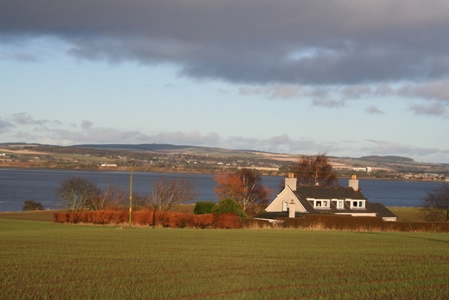
Montrose Basin from South side
2. Project Description
The project comprised 15 tidal turbines with gravity foundations to be placed either side of
the road bridge at Montrose. These would transmit energy to the shore where they would be
connected to a shore station. The power would be transmitted to the GSK Montrose plant. It
was proposed that the array would be installed in 2 phases with a total capacity of up to
0.7MW
3. The Environmental Statement
The principal potential impacts identified and discussed in the ES were:
• Archaeology & cultural heritage
• Seabed ecology
• ornithology
• coastal & sedimentary geology processes
• fish & shellfish
• marine mammals
• marine navigation
• onshore noise & vibration
• onshore traffic & transport
• other sea & land users
• terrestrial geology, hydrology & hydrogeology
• terrestrial habitats & ecology
• landscape, seascape and visual impact
3.1 Environmental sensitivities
The site of the proposal is environmentally sensitive. The Montrose Basin has international
designations as a Special Protection Area (SPA) and Ramsar site and is also a Site of
Special Scientific Interest (SSSI) and Local Nature Reserve. In addition the River South Esk
is designated as a Special Area of Conservation (SAC), with Atlantic salmon and Freshwater
Pearl as the qualifying features. There is also evidence that animals from adjacent protected
areas use the Montrose Basin e.g. harbour seals from the Tay and Eden Estuary SAC.
3.2 The appropriate assessment
The proposed works did require an appropriate assessment under Section 48 of the
Conservation (Natural habitats, &c.) Regulations 1994. The appropriate assessment made
the following conclusion: “The location of the proposed development is characteristic in
having a unique set of environmental and geographic conditions that are combined with
potentially highly sensitive receptors. In light of the assessment Marine Scotland conclude
there is insufficient information to ascertain that the development will not have an adverse
effect on the integrity of the South Esk SAC, the Firth of Tay and Eden Estuary SAC and the
Montrose Basin SPA.”
4. Consultation
This section summaries the project consultation undertaken by Marine Scotland in 2012
4.1 Public consultation
In accordance with Regulation 16 (1) (b) of the MWR Marine Scotland instructed GSK to
place a public notice for two successive weeks. The public notice contained details of:
• the applicant’s name and address
• that an application had been made under the MWR and Part 4 of the Marine (Scotland) Act 2010
• a statement of the nature and location of the project
• the address details of where the application and ES could be inspected during office
hours
• notice that parties could make such requests and representations within 42 days of
the first notice date
The public notice appeared in The Courier (14th & 21st March), The Montrose Review (15th &
27th March) and the Edinburgh Gazette (16th & 20th March)
Marine Scotland received 13 public representations objecting to the application. The
objections were mainly based on the potential impacts of the project on wildlife (particularly
eider ducks, harbour seals and salmon), and the possibility that the turbines could affect
coastal processes and impact sediments of the Montrose Basin. There were also concerns
that the development could interfere with activities of the Montrose Sailing Club and pose a
safety threat to sailors.
4.2 Consultees
As part of the consideration of the application and ES, Marine Scotland conducted a
consultation with advisory and regulatory bodies for comment on the validity of the ES
document and the conclusions of environmental impact drawn. The consultation opened on
16th March 2012 and closed on the 13th April 2012.
4.2.1 Consultee List
Angus Council
Association of Salmon Fishery Boards
BT
Crown Estate
Esk District salmon Fishery Board
Health and Safety Executive
Historic Scotland
Inshore Fisheries Group
Joint Radio Company
Marine Safety Forum
Marine Scotland Compliance
Marine Scotland Science
Maritime and Coastguard Agency
Ministry of Defence
Montrose Harbour
Montrose Sailing Club
Northern Lighthouse Board
Ports and harbours
Royal Yachting Association (Scotland)
RSPB
Scottish Canoe Association
Scottish Fishermans Federation
Scottish Fishermans Organisation
Scottish Wildlife Trust
Scottish Government Planning
SEPA
SNH
Transport Scotland
Whale and Dolphin Conservation Society
4.2.2 Consultee Responses
Angus Council
In conclusion the proposal is a relatively untested technology in a very environmentally
sensitive location, as evidenced by the range of designations associated with Montrose
Basin and the River South Esk and the protected species. Montrose Bridge and Wharf Street
are also important in townscape terms being the southern entry to the main part of Montrose
and also providing public overview of the river/estuary at this part of the town. Based on the
information presented a number of matters remain unresolved or at best inconclusive. It is
clear that there will be at least a moderate impact and in some cases major impact (Atlantic
salmon) on several protected species and habitats and that only through deployment and
monitoring of the first phase, would the various study assumptions and conclusions on
impact of the project on the environment be tested and possibly affirmed. Suggested
measures of mitigation are at this stage unproven. It is certainly not clear that the proposal in
the round can demonstrate compliance with the three tests relating to the implementation of
EC Directive 92/43 – The Habitats Directive.
The positioning of the array, taking up more than half of the width of the channel, will affect
the travel route for several species and because of uncertainty of impact it seems that there
is a need for further baseline data (before any works are undertaken) to better understand
numbers and movements of protected species and the overall effect of the array. Only if the
relevant agencies are agreed that the baseline data concludes that there would be no
significant affect on the designated interests (species and habitats) should the first phase be
constructed.
In relation to noise impact there is no agreed position between the Council and applicant with
regard to baseline information, methodology and outcomes. Chapter 17 should be revisited.
At the very least some discussions between the various parties should be held and if
required additional noise analysis etc undertaken before agreement is given to proceed on
site with the first phase.
With regard to visual impact on designated sites (Montrose conservation area and listed
buildings) and on the amenity of residents in the immediate area/frontage buildings no
evidence has been presented that the potential impact is acceptable. The scale of what will
be visible in the water and over what length of time only adds to the uncertainty of impact.
None of the visualisations attempt to address this aspect with Wharf Street as the backdrop.
The lack of clear information on water height tides and what will be visible over what length
of time and how this affects the built heritage needs to be addressed.
Chapter 23 of the ES sets out the summary of project commitments by chapter and also a
commitment to develop an appropriate monitoring and reporting programme. An indication of
this is given in sections 23.11 – 23.66. However in the event that phase1 is given the go
ahead further survey work (agreed by relevant agencies) should be gathered for a full year,
preferably two years, to fully understand the effects of the first phase of the turbines. If there
is an adverse affect they should be removed. Only if there has been no adverse effect
should the second phase be installed. A further monitoring scheme for 1 – 2 years should be
undertaken, with further monitoring every five years. This would require agreement by the
various agencies on the monitoring measures and values.
It is therefore imperative that all the necessary survey/baseline information is
gathered/available before any structures are in place. This would enable a full understanding
and evaluation of impact to be determined. The Council would wish to be fully satisfied that
relevant agencies have agreed the monitoring regime/timescales etc and only where a full
evaluation of any first phase demonstrated that there was no adverse impact on affected
species would a second phase be approved.
Association of Salmon Fishery Boards
Objection
ASFB recognises the importance of marine renewable energy. However, the environmental
impact assessment has failed to demonstrate that the development will not adversely affect
the integrity of the River South Esk SAC. Where a Natura site is involved, the onus is on the
developer to demonstrate no impact and in the absence of that the precautionary principle
will apply. Under these circumstances, we do not believe that the proposed staged
implementation is compatible with the requirements of the Habitats Directive. On that basis,
we have no alternative but to formally object to the proposed development..
BT
Crown Estate
Esk District salmon Fishery Board
Objection
The Esk Board recognises the importance of the project but in view of its statutory
responsibilities cannot support the introduction of the tidal array on the basis of the current
environmental impact assessment and wishes to lodge an objection for the following
reasons:
• There are many gaps in the information which makes it often impossible to conclude
that there will be no significant effect on fish species
• The work referred to in the Bay of Fundy and elsewhere would seem to contradict the
risk assessment to fish species through collision as presented in the ES
• The requirements of the Habitats Directive require a clear indication the there are no
significant risks prior to the implementation of the project. Under these circumstances
a staged implementation with additional monitoring to ascertain likely effects is not
permissible
Health and Safety Executive
Historic Scotland
No objection, agree with the findings of the ES that impacts on nationally important historic
environmental assets are unlikely to be significant.
Joint Radio Company
Marine Scotland Compliance
Marine Scotland Science
• Spring salmon stocks in South Esk would have limited capacity to absorb additional mortality.
• Since the mid 1990s there has been a marked decline in sea trout numbers,
additional mortality would be undesirable.
• There is a need for much clearer and considered ES.
• The ES is not well supported by literature.
• The ES does not deal with effects on different life cycle stages of diadramous fish
species concerned.
• There is a lack of recent baseline information on the seabed and bathymetry of the
Montrose Basin.
• It is considered likely that sedimentary processes would be slow to respond to the
turbine operation and monitoring between installation phases may not detect change.
• The purpose of the 2D hydrodynamic modelling is not clear.
• There is no evidence to show which marine fish species are present.
• If sandeels are present there would be concern over possible sediment changes.
Maritime and Coastguard Agency
Objection:
• Turbines positioned close to the small boat channel introduces risk, especially
todrifting vessels.
• Lighting and marking requirements need to be agreed with MCA and NLB if licence
granted
• Limited 0.5m clearance during operation leaves no margin for error.
• These points would need to be addressed in ports Emergency Response Plan
Ministry of Defence
Montrose Sailing Club
Objection
We feel that this proposal would represent a risk to the safety of our members, as the
proposed mitigation measures are inadequate. The effective loss of navigational rights and
sailing amenity resulting from the closure of the central span of the road bridge are also of
significant concern to the Club. We consider that the possibility of changes to the
sedimentation patterns within the Basin has not been considered by the applicant, and that
these may further restrict our sailing area in the future. Finally, even if the proposal were to
go ahead with suitable safety mitigation measures, the turbines could be perceived as a
significant safety risk by prospective members who would then look elsewhere or take-up a
different sport. For these outline reasons, the General Committee of Montrose Sailing Club
feel the proposal is detrimental to the long term viability of the Club.
Northern Lighthouse Board
• All reasonable risks have been addressed in NRA.
• During all phases notice to mariners will be required.
• During operation condition of devices should be monitored and contingency plan for
failures.
• The applicant must adhere to all marking and lighting recommended by the NLB.
Ports and harbours
Royal Yachting Association (Scotland)
• The RYA position statement recommends minimum clearance of 2m for dinghies.
• The risk assessment did not consider worst credible accidents.
• Consideration should be give to the time taken to stop blades if collision with a
person.
• Warning signs cannot be seen as mitigation for drifting vessels.
RSPB
Objection
As the proposed development, which is unconnected with site management for nature
conservation, is likely to significantly effect the Montrose Basin SPA, the Conservation
(Natural Habitats, &c) Regulations 1994 (as amended) (the ‘Habitats Regulations’) apply and
the competent authority must carry out an appropriate assessment in view of the SPA’s
conservation objectives to determine whether or not the development will adversely affect
the integrity of the site. RSPB Scotland considers that the Environmental Statement (ES)
does not, in terms of survey effort or data analysis, make a competent assessment of the
likely impacts of the proposal on the Montrose Basin SPA. Further, we believe that the ES
does not contain sufficient information to allow Marine Scotland, as competent authority, to
carry out the necessary Appropriate Assessment.
We do not consider that the proposal has met the requirements of the Regulations since it
has failed to show, beyond reasonable scientific doubt, that there will not be an adverse
impact on the integrity of the SPA. In this situation, the competent authority must take a
precautionary approach. The proposal can therefore only proceed if there are no alternative
solutions and if there are overriding reasons of public interest, neither of which is
demonstrated in the ES.
Scottish Canoe Association
• This section of harbour is not extensively used by kayakers but it is possible.
• The array could present a possible hazard at low tide.
• Mitigation is suggested by way of clear warning signs.
Scottish Fishermans Federation
Scottish Wildlife Trust
Objection
It would be highly inappropriate for Marine Scotland to consent the deployment of
“embryonic technology” in this location. We wish to register our objection to the proposed
development on the grounds that we do not believe it is possible for Marine Scotland to rule
out adverse effects on protected species and habitats.
Scottish Government Planning
No Comments
SEPA
• Reasonable likelihood that the conditions for derogation under the Water Framework
Directive will not be met.
• More information required on scour works, dredging, model calibration and validation,
marine non-native species, noise and piling activity
• Evidence required that fish will be able to migrate.
SNH
Objection
Based on information available and our own appraisal, we consider it cannot be concluded
that there will not be an adverse effect on site integrity to the River South Esk SAC, the Firth
of Tay and Eden Estuary SAC, and the Montrose Basin SPA and Ramsar site. Even with the
phased deployment and monitoring approach, our concerns remain due to insufficient time
and methods to collect robust evidence. Furthermore, we have serious concerns regarding
the potential impacts to other nationally important natural heritage features in the area.
Transport Scotland
Minimal Environmental Impact on trunk road network
Whale and Dolphin Conservation Society
Objection
The Environmental Statement has failed to show, beyond reasonable scientific doubt, that
there will not be an adverse impact on the integrity of the Firth of Tay and Eden Estuary
SAC.
WDCS, IAR, BDMLR and OneKind do not believe that it is possible to rule out adverse
effects on the very small and rapidly declining harbour seal population based on the level of
risk and uncertainty surrounding the effectiveness of monitoring and mitigation measures
proposed and cumulative impacts. As a result, we submit a formal objection to this proposal.
5. Conditions
Not applicable
6. Regulatory Evaluation
6.1 Conclusions
In considering the application, in particular the ES, responses to the consultation and the
relevant provisions of the Marine (Scotland) Act 2010, a full and detailed assessment has not
been made of the potential direct and indirect effects of the proposal. The application
received 7 objections from consultees with others raising serious concerns. Thirteen
objections were also received from the public.
Marine Scotland, as the regulator, are not satisfied with the findings of the ES, and are of the
opinion that the marine elements of the project will have a significant adverse effect on the
environment. The appropriate assessment also concluded that there is insufficient
information to ascertain that the development will not have an adverse effect on the integrity
of the South Esk SAC, the Firth of Tay and Eden Estuary SAC and the Montrose Basin SPA.
6.2 Recommendations
Having carried out assessments of the potential environmental impacts of the proposed
project, the reviewer acting on behalf of Marine Scotland makes the recommendations
below: Marine Scotland are not satisfied that the ES adequately addresses all environmental issues
in relation to the GSK Montrose Tidal Array development and compliance with the Habitats
Regulations has not been demonstrated. Therefore this application for a Marine Licence
must be refused under section 24 (b) of the MWR.
Reviewed by:
Gayle Holland
Date: 7th February 2013
Approved by Roger May
Date 18th March 2013
The Licensing Authority:
Marine Scotland
From: Roger May
Marine Scotland Licensing Operations Team
Marine Renewable Energy Development
February 2013
Cabinet Secretary for Rural Affairs and the Environment
APPLICATION FOR A MARINE LICENCE UNDER PART 4, SECTION 20 OF THE
MARINE (SCOTLAND) ACT 2010 TO CONSTRUCT AND OPERATE A TIDAL ARRAY IN
THE RIVER SOUTH ESK BETWEEN MONTROSE BASIN AND MONTROSE HARBOUR.
Purpose
To seek your determination on the application by GlaxoSmithKline, Montrose to construct and
operate a tidal array in the River South Esk Estuary of up to 0.7 MW.
Priority – Routine.
Background
GlaxoSmithKline (GSK) submitted a marine licence application to Marine Scotland Licensing
Operations Team (MS-LOT) on 30 January 2012 to develop a tidal array in the River South Esk
Estuary. The array would make a small contribution to the renewables obligation and climate change
targets in Scotland. If consented, it would provide energy direct to the GSK Montrose site – supplying
7 % of the site’s needs.
Turbines would be deployed on the river bed either side of the road bridge at Montrose in 2 phases
over 14 months- comprising a total of 15 tidal turbines.
The proposed development site is environmentally sensitive affecting 3 Natura Sites (these are sites of
European Community importance which are designated as such by Member States for the purpose of
protecting natural habitats and species of Community interest under both the Habitats Directive and
the Wild Birds Directive):
1. River South Esk SAC
2. Montrose Basin SPA
3. Firth of Tay and Eden Estuary SAC.
Given the sensitive nature of the location1, GSK undertook an Environmental Impact Assessment
(EIA) – the application was also accompanied by an Environmental Statement (ES). These are usually
only required where the power generated will exceed 1 MW.
Consultation on marine licence applications which is a statutory requirement under section 27 of the
Marine (Scotland) Act 20102 (‘the 2010 Act’) remains a critical component of the licensing process.
The public consultation ended in March 2012 – MS-LOT received a total of 20 objections. These
included from SNH, Association of Salmon Fishery Boards, RSPB, Scottish Wildlife Trust, Whale
and Dolphin Conservation Society, Esk District Salmon Fishery Board and the Montrose Sailing Club.
In addition, 13 objections were from members of the public. In order to inform the licence
1 Further details of proposed location are contained in the Annex B, Para 2d
2 Relevant legal tests to consider when determining marine licence applications –
Annex A
determination process, there have been further discussions with consultees including exchanges of
correspondence and meetings as required.
The objections were mainly based on the potential impacts of the project to wildlife (particularly eider
ducks, harbour seals, and salmon), and the possibility that the turbines could affect coastal process and
impact sediments of the Montrose Basin. It was recognised by SNH and MS-LOT that the consent of
the proposal, as presented, was unlikely to satisfy relevant statutory tests nor comply with the Habitats
Directive and Regulations. The Montrose Sailing club also raised safety issues and concerns that the
turbines could interfere with club activities.
Throughout the Marine Licence process MS-LOT continued close engagement with GSK – advising
them of the terms of the objections received and gave them an opportunity to make representations on
the observations received, as is required by section 27(5) of the 2010 Act.
GSK submitted further information in response which included additional monitoring. These
proposals were reviewed by SNH and Marine Scotland Science, however, MS-LOT have not received
the necessary reassurance from the applicant or from other correspondents that there would be no
adverse impact upon the integrity of the protected sites if the project was to be taken forward, as
proposed.
GSK employed RPS Energy (Environmental Consultants) to conduct an independent review of the
ES. RPS concluded that further work was necessary to mitigate for likely significant impacts on the
Natura Sites. Marine Scotland and SNH met with RPS and GSK on the 5/11/2012 to review the
report. Marine Scotland met with GSK on the 7/11/2012 to provide feedback on the report and
briefed GSK on the likely findings of an Appropriate Assessment. Marine Scotland noted the
proposed further works but did not feel that they would provide sufficient information to alter the
negative conclusions of an Appropriate Assessment or identify mitigation methods to reduce any
impacts to an acceptable level. Marine Scotland also reviewed the potential for other technologies at
this site and concluded that until further information on actual impacts from these technologies was
available that it was unlikely that any other device could be deployed at this site without impacting on
the qualifying interest of the Natura sites. Marine Scotland recommended generating from renewable
sources at other sites, feeding the electricity generated into the grid and offsetting this against the
power used by the company at the Montrose facility.
Marine Scotland reviewed RPS’s report and carried out, in line with the Habitats Directive and
Regulations, an Appropriate Assessment (Annex B) of the potential impacts on the Natura sites which
was agreed with SNH. The results of the Appropriate Assessment are that adverse impact on site
integrity cannot be ruled out for all 3 Natura Sites if the proposal is approved.
All representations that have been received by Marine Scotland in connection with the licence
application must, in terms of section 27(6) of the 2010 Act, be taken into account by you when
determining the application.
Options
• (Option 1) Under section 28 of the Marine (Scotland) Act 2010 you can call a Public Local
Inquiry (PLI). Having considered all the representations and all other material considerations,
it is considered that it is not appropriate to cause a PLI to be held in this case. It is considered
that you are properly able to weigh up all the conflicting issues without needing to hold an
inquiry.
• (Option 2) If in respect of the application it is considered by you that the statutory tests under
the 2010 Act are satisfied, and if it is shown that the approval of the proposal would not
contravene EU law (ie the proposal would either not adversely affect the integrity of the
Natura sites or it would adversely affect the sites but there are considerations of overriding
public interest which justify the taking forward of the project notwithstanding the negative
implications) you may then grant a licence with or without conditions under section 29 of The
Marine (Scotland) Act 2010. In this case it is considered that this is not an option.
• (Option 3) You can refuse the application for a licence under section 29 of the 2010 Act
where, on the basis of all of the evidence presented in connection with the application, you
consider that the legal tests (as set out above, below and in Annex A) are not satisfied.
MSLOT have a strong track record in issuing informed marine licence decisions based on due
process, sound science and expert judgement. Under the Habitats Regulations you have a
general duty when exercising your functions to have regard to the requirements of the Habitats
Directive and the Wild Birds Directive. On the information provided given the very clear
possibility and risk of significant and unacceptable impacts resulting from the licence
application being granted in an environmentally sensitive area it is our judgement and
recommendation that this licence application should be refused.
It is considered that the legal tests in the case have not been met. On the basis of all of the
information available it is considered that you cannot ascertain with certainty that the proposal will
not have any significant adverse impacts on the environment (which in this case is highly sensitive
and of high value and, as such, is protected by measures taken under European law) and the local
amenity.
Furthermore, it is considered from the information available that you may be satisfied that no suitable
prevention, mitigation or compensation measures can be put in place. There are no imperative reasons
of overriding public interest in the case which justify the taking forward of the proposal
notwithstanding the negative implications.
To grant the licence application would contravene EU law. By section 29(6) of the 2010 Act you are
not permitted to grant a licence where to do so would contravene international law.
In terms of the 2010 Act and the Marine Licensing Appeals (Scotland) Regulations 2011 it will be
possible for GSK to appeal to the sheriff court against any decision to refuse the licence application.
On determining an appeal the sheriff may dismiss the appeal or allow the appeal and quash the
decision in whole or in part.
It is considered that there are good grounds for refusing the marine licence application in this case.
The case has been referred to SGLD for advice/comment before being passed to you.
Recommendation
Following a thorough examination of the GSK marine licence application MS-LOT
recommend that you refuse the application.
On the basis of all of the evidence that has been presented in connection with the licence
application it is considered that the legal tests which are set out within sections 3 and 27 of the
2010 Act and article 6 of the Habitats Directive and regulations 48 and 49 of the Habitats
Regulations which must all be satisfied before the marine licence application may lawfully be
approved in this case are not met.
The environment in this case is highly sensitive and of high value and as such protected by
measures taken under European law. An appropriate assessment has been undertaken in
connection with the proposal as is required by Article 6(3) of the Habitats Directive and regulation
48 of the Habitats Regulations. The assessment, a copy of which has been provided to the
applicant, concludes that there is insufficient information to ascertain that the development will
not have an adverse effect on the integrity of the 3 Natura sites which are located nearby the site
for the proposal.
Given the terms of the information that has been made available to you, particularly the terms of
the appropriate assessment, all of which the applicant has, in terms of the 2010 Act, been given an
opportunity to address and comment upon to you, it is considered that you cannot ascertain with
certainty that the proposal will not have a significant adverse impact on the environment and the
local amenity.
It has not been shown that any suitable prevention, mitigation or compensation measures can be
put in place to allow the proposal to proceed notwithstanding the negative implications. Nor has it
been shown that it would be possible to attach conditions to the grant of a licence in order to
satisfy the legal tests.
In the circumstances of the case, as narrated, to grant the licence application would contravene EU
law. The Marine (Scotland) Act 2010 prohibits you from granting a licence authorising activity
which is contrary to international law.
Subject to your agreement, in line with the legislation and consistent with the treatment of other
Marine Licence applications – the refusal of this licence will be made available on the Scottish
Government website.
Roger May
45473
Annex A
Relevant legal tests to consider when determining marine licence applications
Marine (Scotland) Act 2010
By section 3 of the 2010 Act when exercising any function that affects the Scottish marine area (this
includes the determination of marine licence applications) you have a general duty to act in the way
best calculated to further the achievement of sustainable development, including the protection and,
where appropriate, the enhancement of the health of the area.
Under section 4 of the 2010 Act when exercising any function that affects the Scottish marine area
either under that Act, the Climate Change (Scotland) Act 2009 or any other Act you must act in the
best way calculated to mitigate and adapt to climate change.
When determining marine licence applications you must, in terms of section 27 of the 2010 Act, have
regard to the need to protect the environment and human health as well as the need to prevent
interference with legitimate users of the sea (the definition of ‘sea’ in the 2010 Act includes tidal
waters of rivers and estuaries) and such other matters as you may consider relevant.
In addition, you must have regard, amongst other things, to the practical availability of any alternative
method of taking forward the proposed development as well as having regard to the effects of any use
intended to be made to the project once it has been constructed.
Section 29 of the 2010 Act allows you to consider marine licence applications and to grant licences
either unconditionally or subject to conditions, or to refuse such applications. The conditions that may
be attached to a licence may, under section 29(2) of the 2010 Act, relate to the activities authorised by
the licence, precautions to be taken or works to be carried out in connection with the activities and the
monitoring of the licensed activities. Section 29(3) of the Act sets out some particular conditions that
may be attached to a licence.
Furthermore, under section 29(6) of the 2010 Act you are not authorised to grant a marine licence to
carry on any activity which is contrary to international law.
Habitats Directive and Habitats Regulations
In terms of the Habitats Directive (article 6) and the Habitats Regulations 1994 (regulation 48(5)) you
may only agree to the proposal being taken forward only after having ascertained that it will not
adversely affect the integrity of the Natura sites and, if appropriate, after having obtained the opinion
of the general public. In considering whether the proposal will adversely affect the integrity of the
sites you must have regard to the manner in which it is proposed to be carried out.
This is not to say that plans or projects which have been assessed as having negative implications for
such sites can never be approved. Proposals can be approved in spite of a negative assessment where
the project in question must be carried out for imperative reasons of overriding public interest,
including those of a social or economic nature. In such cases compensatory measures must be taken
to ensure that the overall coherence of the Natura network of protected sites is protected.
Annex B
PROFORMA FOR RECORDING MARINE SCOTLAND’S CONSIDERATION OF A PROPOSAL
AFFECTING A POTENTIAL/DESIGNATED SAC OR SPA
SITE: GSK Tidal Array, River South Esk Estuary, Montrose
FILE REF: FKB/Z248
Appropriate Assessment – Conclusion
The location of the proposed development is characteristic in having a unique set of environmental
and geographic conditions that are combined with potentially highly sensitive receptors. In light of
the assessment Marine Scotland conclude that there is insufficient information to ascertain that the
development will not have an adverse effect on the integrity of the South Esk SAC, the Firth of Tay
and Eden Estuary SAC and the Montrose Basin SPA.
1a. Name of Natura site affected & current status available from:
http://gateway.snh.gov.uk/sitelink/siteinfo.jsp?pa_code=8409
http://gateway.snh.gov.uk/sitelink/siteinfo.jsp?pa_code=8512
1. River South Esk SAC
2. Firth of Tay and Eden Estuary SAC
3. Montrose Basin SPA
1b. Name of component SSSI if relevant
Not relevant for this assessment
1c. European qualifying interests & whether priority/non-priority:
1. River South Esk SAC
• Atlantic salmon
• Freshwater pearl mussel
2. Firth of Tay and Eden Estuary SAC
• Common seal
3. Montrose Basin SPA
• Dunlin (Calidris alpina alpina)*
• Eider (Somateria mollissima)*
• Greylag goose (Anser anser)
• Knot (Calidris canutus)
• Oystercatcher (Haematopus ostralegus)*
• Pink-footed goose (Anser brachyrhynchus)
• Redshank (Tringa totanus)
• Shelduck (Tadorna tadorna)*
• Wigeon (Anas penelope)*
• Waterfowl assemblage
* indicates assemblage qualifier only.
1d. Conservation objectives for qualifying interests:
Annex II Species Conservation Objectives
1. River South Esk SAC
To avoid deterioration of the habitats of the qualifying species or significant disturbance to the
qualifying species, thus ensuring that the integrity of the site is maintained and the site makes an
appropriate contribution to achieving favourable conservation status for each of the qualifying
features; and To ensure for the qualifying species that the following are maintained in the long term:
• Population of the species, including range of genetic types for salmon, as a viable component
of the site
• Distribution of the species within site
• Distribution and extent of habitats supporting the species
• Structure, function and supporting processes of habitats supporting the species
• No significant disturbance of the species
• Distribution and viability of freshwater pearl mussel host species
• Structure, function and supporting processes of habitats supporting freshwater pearl mussel
host species
2. Firth of Tay and Eden Estuary SAC
To avoid deterioration of the habitats of the qualifying species or significant disturbance to the
qualifying species, thus ensuring that the integrity of the site is maintained and the site makes an
appropriate contribution to achieving favourable conservation status for each of the qualifying
features; and
• To ensure for the qualifying species that the following are maintained in the long term:
• Population of the species as a viable component of the site
• Distribution of the species within site
• Distribution and extent of habitats supporting the species
• Structure, function and supporting processes of habitats supporting the species
• No significant disturbance of the species
3. Montrose Basin SPA
To avoid deterioration of the habitats of the qualifying species or significant disturbance to the
qualifying species, thus ensuring that the integrity of the site is maintained; and
To ensure for the qualifying species that the following are maintained in the long term:
• Population of the species as a viable component of the site
• Distribution of the species within site
• Distribution and extent of habitats supporting the species
• Structure, function and supporting processes of habitats supporting the species
• No significant disturbance of the species
PROPOSAL DETAILS
2a. Proposal title & name of consultee (i.e. applicant or competent authority)
GlaxoSmithKline (GSK) Montrose Tidal Array
Marine
Scotland
2b. Date of Consultation:
14th May
2012
2c. Type of Case:
Offshore renewable tidal array development
2d. Details of proposed operation (inc. location, timing, methods):
GSK propose to develop a tidal array in the River South Esk Estuary, Montrose. The capacity would
be up to 0.7MW, comprising 15 tidal turbines with gravity foundations. These would be deployed
either side of the road bridge at Montrose in 2 phases over 14 months. These turbines would transmit
electricity to the shore with armoured cables where they would connect to a shore station. The power
would then be transmitted to the GSK Montrose site.
The proposed development is located approximately 4.6 km downstream from The River South Esk
SAC, approximately 32 km north of The Firth of Tay and Eden Estuary SAC and 100 metres from the
Montrose Basin SPA.
ASSESSMENT IN RELATION TO REGULATION 20 or 48
3a. Is the operation directly connected with or necessary to conservation management of the
site? NO If YES give details:
The operation is not connected with or necessary to conservation management of the site.
If yes and it can be demonstrated that the tests in 3b have been applied to all the interest features in
a fully assessed and agreed management plan then consent can be issued but rationale must be
provided, including reference to management objectives. If no, or if site has several European
qualifying interests and operation is not directly connected with or necessary to the management of
all of these then proceed to 3b.
3b. Is the operation likely to have a significant effect on the qualifying interest? Repeat for
each interest on the site.
1. River South Esk SAC
During the consultation phase SNH advised that the development would be likely to have a
significant effect (LSE) on Atlantic Salmon and Freshwater Pearl Mussel (FWPM) from the South
Esk SAC. This is due to:
• the potential for collision risk and barrier effect from the array during operation.
• disturbance during installation.
• potential disturbance and injury from electromagnetic fields (EMF), noise, water pressure
change and cavitation effects.
• potential changes to sedimentation patterns, tidal height and flushing within the Montrose
Basin caused by the operational turbines which may have a direct effect on the distribution,
extent, structure, function and supporting processes of habitats supporting the qualifying
feature, and an indirect effect on the maintenance of the populations as a viable component
of the SAC.
FWPM rely on Atlantic Salmon as a host species during the larval stage of their reproduction,
therefore any impacts on Atlantic Salmon may have an impact on FWPM.
2. Firth of Tay and Eden Estuary SAC
It has not been established in the Environmental Statement whether the common seals using the
Montrose Basin haul out are connected with the SAC. Due to a lack of scientific evidence a
precautionary approach assumes that there is connectivity. SMRU have data from 12 tagged seals
from the SAC, one of which visited Montrose during the breeding season.
LSE on Common Seals from the Firth of Tay and Eden Estuary SAC was therefore identified due to:
• potential for disturbance during installation, maintenance and decommissioning.
• potential for collision risk or disturbance/displacement during turbine operation.
• potential for barrier effect from the presence of turbines in the water column.
• potential changes to sedimentation patterns, tidal height and flushing within the Montrose
Basin caused by the operational turbines which may have a direct effect on the distribution,
extent, structure, function and supporting processes of habitats supporting the qualifying
feature, and an indirect effect on the maintenance of the populations as a viable component
of the SAC.
• potential from “corkscrew” injury caused by vessels with ducted propellers during installation,
maintenance and decommissioning.
3. Montrose Basin SPA
Montrose Basin SPA is classified for its aggregation of non-breeding birds. It is also classified as a
Ramsar site for its estuarine habitats and wintering waterfowl. In Scotland it is a matter of policy as
set out in February 2010 Scottish Planning Policy that International Ramsar sites are also Natura
sites and/ or Sites of Special Scientific Interest and are protected under the relevant statutory
regimes. Therefore where the bird interests of the Montrose Basin Ramsar site correspond with
those of an overlapping SPA there is no need to consider them separately.
LSE on all the qualifying features of the Montrose Basin SPA was identified due to:
• potential changes to sedimentation patterns, tidal height and flushing within the Montrose
Basin caused by the operational turbines which may have a direct effect on the distribution,
extent, structure, function and supporting processes of habitats supporting the qualifying
features, and an indirect effect on the maintenance of the species populations as a viable
component of the SPA.
LSE on Eider ducks from the Montrose Basin SPA was identified due to:
• potential for disturbance during installation and operation
• potential for collision risk during turbine operation
3c. Appropriate assessment of the implications for the site in view of the site’s conservation objectives.
i) Describe for each European qualifying interest the potential impacts of the proposed operation detailing which
aspects of the proposal could impact upon them.
ii) Evaluate the significance of the potential impacts, e.g. whether short/long term, reversible or irreversible,
and in relation to the proportion/importance of the interest affected, and the overall effect on the site’s
conservation objectives. Record if additional survey information or specialist advice has been obtained.
1. River South Esk SAC
SNH concluded that on the basis of the information presented in the Environmental Statement it
could not be ascertained that there would be no adverse effect on site integrity due to a lack of
data on both the behaviour of salmon in the Montrose channel and the interaction of these fish
with the proposed turbines. Furthermore they considered that it would be unlikely that the applicant
would be able to gather sufficiently robust data to further inform our understanding regarding the
potential for an adverse effect on site integrity.
The response to the consultation received on the 23rd April 2012 from Marine Scotland Science
Freshwater Fish Laboratory (MSS FFL) stated that there are concerns over the health of the early
running salmon stocks and that these stocks would have a very limited capacity to absorb
additional mortality associated with new anthropogenic activity. There was insufficient information
in the ES to assess the impacts of the turbines on salmon.
In May 2012 Marine Scotland received 2 documents from GSK :
1. “GSK Montrose tidal project proposed fish monitoring” which gave details of proposed
monitoring which it was thought would fill the information gaps in the ES and provide enough
information to assess the impact of the turbines on the salmon from the South Esk SAC.
2. “Preliminary summary of Montrose split beam sonar testing” which gave data from a 2 day trial
of the split beam sonar system proposed as a fish monitoring method.
These documents were passed on to SNH and MSS FFL. In response SNH advised that the
proposed monitoring work would be unlikely to provide sufficiently robust data to allow Marine
Scotland to conclude no adverse effect on site integrity.
MSS FFL detailed many problems with the proposed monitoring including:
• Sampling effort (72 hours per month) likely to be inadequate to capture fish movements if
these are strongly temporally aggregated
• The ability of the equipment to distinguish between species of fish and size would be
almost nil
• The equipment would be unlikely to detect smolts
GSK arranged for RPS to conduct a review of the Environmental Statement. This was presented to
Marine Scotland on the 5th November 2012 GSK . Although this review identified many of the
shortcomings of the original ES it did not provide the confidence that the applicant would be able
to collect the information required to conclude that there would be no adverse impact on site
integrity due to the sites unfavourable status and its very limited capacity to withstand additional
salmon mortality.
2. Firth of Tay and Eden Estuary SAC
SNH concluded that there was insufficient information in the Environmental Statement to conclude
no adverse effect on the integrity of the site. The collision risk modelling results in the ES predicted
6.9 seal collisions per year for the 15 turbines. Although this figure is precautionary, it raises
serious concerns considering that the current status of the qualifying feature is unfavourable
declining and the Potential Biological Removal (PBR) for common seals in the East Coast
Management area is only 3 individuals for the year. Although an active sonar and shut-down was
proposed as mitigation, minimal information was provided in the ES.
SNH concluded that in order to inform an appropriate assessment a detailed assessment of the
active sonar and shut-down procedure would be required along with further modelling of the
coastal processes and an assessment of how any changes may have a potential impact on the
qualifying feature and their conservation objectives.
3. Montrose Basin SPA
SNH concluded that there was insufficient information in the Environmental Statement to conclude
no adverse effect on the integrity of the site. SNH advised that order to inform an appropriate
assessment a revised collision risk model would be required along with further modelling of the
coastal processes and an assessment of how any changes may have a potential impact on the
qualifying feature and their conservation objectives.
It is believed that additional surveys, data analysis and modelling work suggested in the RPS
review of the Environmental Statement would provide Marine Scotland with sufficient information
to complete an appropriate assessment. However as this additional survey work and analysis has
not been carried out in order to inform this appropriate assessment, it is concluded based on the
information presented to date, that there is insufficient evidence to be able to conclude no adverse
effect on site integrity.
iii) In the light of the assessment, ascertain whether the proposal will not adversely affect the integrity
of the site for the European interests. Separate conclusions must be provided if the SAC and/or SPA
and/or Ramsar site. If conditions required, proceed to 3d.
Appropriate Assessment
The location is characteristic in having a unique set of environmental and geographic conditions that
are combined with potentially highly sensitive receptors. In light of the assessment Marine Scotland
conclude that there is insufficient information to ascertain that the development will not have an
adverse effect on the integrity of the South Esk SAC, the Firth of Tay and Eden Estuary SAC and
the Montrose Basin SPA.
4. RESPONSE
a) Marine Scotland Comments
For Marine Scotland advice to other authorities:
The development proposed by GSK for the deployment of 15 tidal turbines in the River South Esk
Estuary, Montrose may have an adverse impact on the integrity of South Esk SAC, the Firth of Tay
and Eden Estuary SAC and the Montrose Basin SPA.
For Marine Scotland response to request for opinion on effects of permitted development:
The development may have an adverse impact on the integrity of South Esk SAC, the Firth of Tay
and Eden Estuary SAC and the Montrose Basin SPA.
For Marine Scotland response to application:
Under section 48 of The Conservation (Natural Habitats &c.) Regulations 1994 as amended Marine
Scotland as the Competent Authority must reject the application.
Name of assessor
Gayle Holland
Date : 26th November 2012
GAME, SET & MATCH TO COMMON SENSE I WOULD SAY! NICE THAT ON THIS OCCASION THE SCIENCE FULLY SUPPORTS THE ORDINARY MAN’S GUT FEELING!
